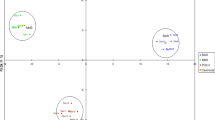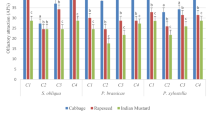Abstract
The role of jute, Chorchorus capsularis (cv. Sonali; JRC-321), leaf physicochemical cues in the form of cuticular surface ultrastructures and wax chemicals mainly n-alkanes and free fatty acids (FFAs) on attraction and oviposition preference of Diacrisia casignetum Kollar (Lepidoptera: Arctiidae) was studied under laboratory conditions. The GC–MS and GC-FID analyses of mature jute leaf surface wax indicated the presence of 257.04 and 171.36 µg/leaf n-alkanes and FFAs, respectively. Eighteen n-alkanes from n-C16 to n-C36 and 13 FFAs from C12:0 to C20:0 were detected in the leaf surface wax. The cuticular surface ultrastructures and its chemicals have been demonstrated in this work to serve as cues for eliciting attraction and oviposition responses of the adults to mature jute leaves. The synthetic combination mixture mimicking the natural surface wax components of 4 n-alkanes (n-C17, n-C18, n-C27, n-C29) and 5 FFAs (C16:0, C16:1, C18:1, C18:2, C18:3) was most attractive to D. casignetum adults, whereas same mixtures excluding 2 n-alkanes (n-C27, n-C29) indicated significantly optimum oviposition preference at leaf equivalent (µg/leaf) concentrations that may be used for this pest management program as baited trap. The present study will also ensure sustainability of success in integrated pest management (IPM) in the form of green pest management (GPM) in the near future.


Similar content being viewed by others
References
Adati T, Matsuda K (2000) The effect of leaf surface wax on feeding of the strawberry leaf beetle, Galerucella vittaticollis, with reference to host plant preference. Tohoku J Agric Res 50:57–61
Aktar MW, Sengupta D, Chowdhury A (2009) Impact of pesticides use in agriculture: their benefits and hazards. Interdiscip Toxicol 2:1–12. https://doi.org/10.2478/v10102-009-0001-7
Bernays EA (2001) Neural limitations in phytophagous insects: implications for diet breadth and evolution of host affiliation. Ann Rev Entomol 46:703–727
Chapman RF (2003) Contact chemoreception in feeding by phytophagous insects. Ann Rev Entomol 48:455–484
Chapman RF, Bernays EA (1989) Insect behavior at the leaf surface and learning as aspects of host plant selection. Cell Mol Life Sci 45:215–222
Cunningham JP, Zalucki MP, West SA (1999) Learning in Helicoverpa armigera (Lepidoptera: Noctuidae): a new look at the behaviour and control of a polyphagous pest. Bull Entomol Res 89:201–207
Desneux N, Decourtye A, Delpuech J-M (2007) The sublethal effects of pesticides on beneficial arthropods. Ann Rev Entomol 52:81–106. https://doi.org/10.1146/annurev.ento.52.110405.091440
Egan JF, Bohnenblust E, Goslee S, Mortensen D, Tooker J (2014) Herbicide drift can affect plant and arthropod communities. Agric Ecosyst Environ 185:77–87. https://doi.org/10.1016/j.agee.2013.12.017
Ehrlich PR, Raven PH (1964) Butterflies and plants: a study in coevolution. Evolution 18:586–608
Finch S, Collier RH (2000) Host-plant selection by insects—a theory based on ‘appropriate/inappropriate landings’ by pest insects of cruciferous plants. Entomol Exp Appl 96:91–102
Foster SP, Howard AJ (1998) Influence of stimuli from Camellia japonica on ovipositional behavior of generalist herbivore Epiphyas postvittana. J Chem Ecol 24:1251–1275
Heinz CA (2008) Host plant odor extracts with strong effects on oviposition behavior in Papilio polyxenes. Entomol Exp Appl 128:265–273
Jetter R, Schaffer S, Riederer M (2000) Leaf cuticular waxes are arranged in chemically and mechanically distinct layers: evidence from Prunus laurocerasus L. Plant Cell Environ 23:619–628
Koschier EH, Kogel WJD, Visser JH (2000) Assessing the attractiveness of volatile plant compounds to western flower thrips Frankliniella occidentalis. J Chem Ecol 26:2643–2655
Li G, Ishiwaka Y (2006) Leaf epicuticular wax chemicals of the Japanese knotweed Fallopia japonica as oviposition stimulant for Ostrinia latipennis. J Chem Ecol 32:595–604
Malik U, Barik A (2015) Free fatty acids from the weed, Polygonum orientale leaves for attraction of the potential biocontrol agent, Galerucella placida (Coleoptera: Chrysomelidae). Biocontrol Sci Technol 25:593–607
McCallum EJ, Cunningham JP, Lücker J, Zalucki MP, De Voss JJ, Botella JR (2011) Increased plant volatile production affects oviposition, but not larval development, in the moth Helicoverpa armigera. J Exp Biol 214:3672–3677
Mukherjee A, Sarkar N, Barik A (2014) Long-chain free fatty acids from Momordica cochinchinensis leaves as attractants to its insect pest, Aulacophora foveicollis Lucas (Coleoptera: Chrysomelidae). J Asia-Pacific Entomol 17:229–234
Parr MJ, Tran BMD, Simmonds MSJ, Kite GC, Credland PF (1998) Influence of some fatty acids on oviposition by the bruchid beetle, Callosobruchus maculatus. J Chem Ecol 24:1577–1593
Renwick JAA, Chew FS (1994) Oviposition behavior in lepidoptera. Ann Rev Entomol 39:377–400
Roy N (2014) Role of Chorchorus capsularis phytochemicals on the feeding dynamics of Diacrisia casignetum Kollar (Lepidoptera: Arctiidae). J Entomol Zool Stud 2:227–236
Roy N (2015) Life table and population parameters of Diacrisia casignetum Kollar (Lepidoptera: Arctiidae) on jute, Chorchorus capsularis (cv. Sonali; JRC-321), leaves. Int J Fauna Biol Stud 2:23–29
Roy N, Barik A (2010) The role of volatiles in tritrophic interactions. Environ Ecol 28:352–355
Roy N, Barik A (2012) Alkanes used for host recognition by the arctiid moth, Diacrisia casignetum Kollar. J Entomol Res 36:345–350
Roy N, Barik A (2012) The impact of variation in foliar constituents of sunflower on development and reproduction of Diacrisia casignetum Kollar (Lepidoptera: Arctiidae). Psyche. https://doi.org/10.1155/2012/812091
Roy N, Barik A (2013) Influence of four host plants on feeding, growth and reproduction of Diacrisia casignetum (Lepidoptera: Arctiidae). Entomol Sci 16:112–118
Roy N, Barik A (2014) Long-chain fatty acids: semiochemicals for host location by the insect pest, Diacrisia casignetum. J Kansas Entomol Soc 87:22–36
Roy N, Chattopadhyay C, Barik A (2013) Assessing the attractiveness of odorous esterified fatty acids to arctiid moth, Diacrisia casignetum Kollar. Ecoscan 3:87–91
Roy N, Laskar S, Barik A (2012) Determination of n-alkane profile through developmental state of sunflower leaves. South Pacific J Nat Appl Sci 30:72–76
Roy N, Laskar S, Barik A (2012) The attractiveness of odorous esterified fatty acids to the potential biocontrol agent, Altica cyanea. J Asia-Pacific Entomol 15:277–282
Sarkar N, Mukherjee A, Barik A (2013) Long-chain alkanes: allelochemicals for host location by the insect pest, Epilachna dodecastigma (Coleoptera: Coccinellidae). Appl Entomol Zool 48:171–179
Sarkar N, Mukherjee A, Barik A (2013) Olfactory responses of Epilachna dodecastigma (Coleoptera: Coccinellidae) to long-chain fatty acids from Momordica charantia leaves. Arth-Plant Int 7:339–348
Schäpers A, Carlsson MA, Gamberale-Stille G, Janz N (2015) The role of olfactory cues for the search behavior of a specialist and generalist butterfly. J Insect Behav 28:77–87
Schoonhoven LM, Van Loon JJA, Dicke M (2005) Insect-plant biology. Oxford University Press, Oxford
Singh R, Koul O, Rup PJ, Jindal J (2011) Oviposition and feeding behavior of the maize borer, Chilo partellus, in response to eight essential oil allelochemicals. Entomol Exp Appl 138:55–64
Srinivasan R, Su FC, Huang SS (2013) Oviposition dynamics and larval development of Helicoverpa armigera on a highly preferred unsuitable host plant, Solanum viarum. Entomol Exp Appl 147:217–224
Wadhera D, Capaldi-Phillips ED (2014) A review of visual cues associated with food on food acceptance and consumption. Eat Behav 15:132–143
Yang G, Zhang Y-N, Gurr GM, Vasseur L, You M-S (2016) Electroantenogram and behavioral responses of Cotesia plutellae to plant volatiles. Insect Sci 23:245–252
Yi X, Liu J, Wang P, Hu M, Zhong G (2014) Contacting is essential for oviposition deterrence of Rhodojaponin-III in Spodoptera litura. Arch Insect Biochem Physiol 86:122–136
Zar JH (1999) Biostatistical analysis. Prentice Hall, Upper Saddle River
Acknowledgements
The work was funded by a minor research project provided by the University Grants Commission [F. No. PSW-025/13-14], New Delhi, Government of India. The author is highly grateful to the USIC department for SEM study, Chemical Ecology Laboratory for GC-FID and the Department of Chemistry for FT-IR, The University of Burdwan, West Bengal, India. He is also thankful to the IICB, Kolkata, West Bengal, India, for GC–MS analysis.
Author information
Authors and Affiliations
Contributions
NR designed the whole study including sample collection, chemical analysis and data analysis and prepared the manuscript.
Corresponding author
Ethics declarations
Conflict of interest
The author declares that there is no conflict of interest.
Electronic supplementary material
Below is the link to the electronic supplementary material.
Rights and permissions
About this article
Cite this article
Roy, N. Jute Leaf Physicochemical cue-mediated Behavioral Responses of Diacrisia casignetum Kollar. Agric Res 8, 287–296 (2019). https://doi.org/10.1007/s40003-018-0362-2
Received:
Accepted:
Published:
Issue Date:
DOI: https://doi.org/10.1007/s40003-018-0362-2




